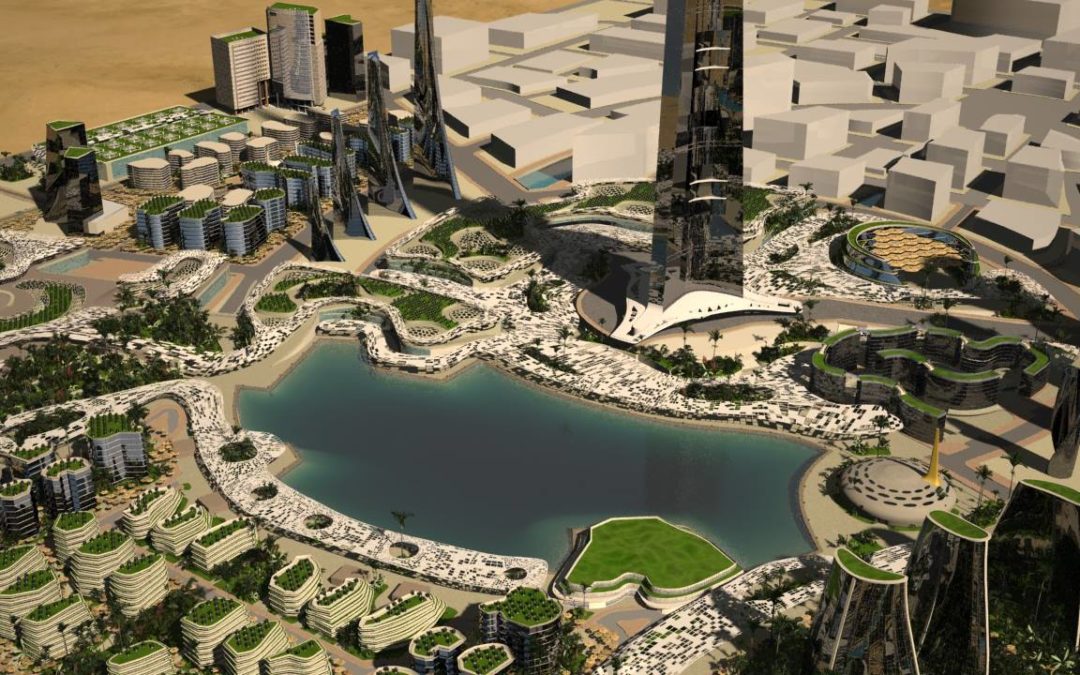
Future Shock? ‘Building Siris,’ Building Trust And Securing A Smarter World
(Above: The initial conceptual master plan for Kingdom City, Jeddah, Saudi Arabia; courtesy Paul Doherty.)
By Kadambari M. Wade
Architect. Innovator. Integrator. Traveler. Paul Doherty, President & CEO of TDG [The Digit Group, Inc.], is one of the world’s foremost authorities on the coming together of the worlds of built spaces and technology, and the processes that bind and define them. He now spends his time traveling around the globe, implementing Smart City solutions for governments and private groups. Biometrica caught up with Doherty, also the co-founder of the AEC Hackathon — which launched at the Facebook Headquarters three years ago — for a fascinating conversation on the future of security in the cyber-physical environments our world is moving toward. Here is Part I of that discussion.
KMW: Let’s get down to the basics straightaway. How does innovation change the game as far as built spaces go?
PD: Innovation changes things, sometimes, it changes everything. A hundred and fifty years ago, an innovation like the elevator changed the shape of cities. What we’re looking at right now, whether it’s the Internet of Things, the advent of autonomous vehicles, etcetera, they’re also going to change the shape of cities. Take autonomous vehicles. Our roads will be narrower, because you don’t need extra space to drive. There won’t be any need for traffic lights, and parking lots will be a thing of the past.
Why will roads be narrower?
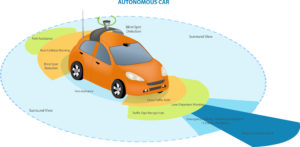
Well, because you don’t have to make allowance for the human fudge factor. The reason roads are so wide is because, in case you lose control, you have the space to get back control of your car relatively easily — that’s why roads are far wider than the actual width of vehicles. In the world of autonomous vehicles though, you have no need for that extra room; the driving will be more perfect than human, and it [the vehicle] will have a different type of relationship with humans — it has the intelligence to not run you over. This, in turn, would lead to a different way of thinking about things like how you walk through a city, or how you cross a road. Those intersections of design are really interesting, and it really does create a cyber-physical relationship with the results. Those results are narrower lanes, and curbs that are necessary only because that’s where the streetlights will be.
So we will still have streetlights? Would that with safety and security needs in mind?
Actually, we have no need for big street lamps in our Smart Cities, because of the way we’re able to use optics, and because of the way we’re able to use LED. A road will be fed by a kind of thermal profile way of distributing a stream of light.
That seems quite out of the movies, doesn’t it?
We’re actually using the technology being used by the Department of Defense with the U.S. Navy, it’s what they use when they line up aircraft carrier runways. Now we’ll put that into roadways, but the road, additionally, will also have an additive in it, which will reflect and allow for an even flow of light, so the entire roadway gets lit up, almost like a bolt.
Logically, that probably also means more energy efficiency, because we’re not using high-energy street lighting.
Yes! And with lower amounts of energy, you get better safety because of the way light is dispersed. Then, because it’s LED, and LED has a certain type of wavelength, you can run Internet Protocol on top of it. So now you also have the 10G Wi-Fi network that’s built within the lighting of the roads.
It’s pretty incredible, how it all ties together.
It does. It’s like an ecosystem.
But that brings us to the question of someone hacking into that physical ecosystem. That’s got to be a worry, it would be for most of us.
That is our biggest question actually — security. How do you lock that down? We’ve all seen science fiction or futuristic thriller-type movies, and have watched bad people take over the traffic lights of cities.
At the very least. Among other things!
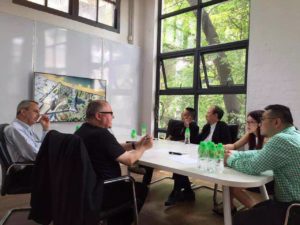
We’ve been thinking of that as well. And the question we’ve focused on is this: What are we trying to do in terms of security? We want to make sure that the physical and the cyber are both protected in terms of security in very big ways, and some of those ways are to take a look at the actual bits and bytes that make up a piece of data themselves. Instead of waiting for that data to be put into a document, like we do with computers, it’s really the flow of data that is more important to us — to city managers, city designers, city constructors. And because of that flow of data, we have to make sure that, at any given time, wherever that data wants to go, it’s secured, even through transmission.
Isn’t transmission secured already?
The way technology is secured today, we first wait for the effect of what is available to really then “wrap” it, like a file, a document, a folder, or even a transmission like a VPN [Virtual Private Network]. What we’re now saying is this: Let’s get ahead of that, and start to secure that digital piece of data so that it wraps itself like it’s invisible, wherever it goes.
Wow. So if you can’t see it, you can’t hack it?
Yes. One of the big complaints out there with autonomous vehicles is, “Oh, you know, the hackers are going to get in.” Well, what happens when your operating system is invisible, so they don’t even know what to hack? That’s the cat and mouse game that’s being developed, with some really cool stuff coming out of places like MIT.
Back to cyber-physical systems, they’re pretty much already there: From the Smart Grid to the smartphone to talking refrigerators to intelligent buildings. From the security of physical spaces aspect, what would the new nature of security look like? One part, of course, would be to make the OS invisible to malcontents, as you’ve mentioned, but how would you look at the future of security in our connected ecosystem?
Great question. When it comes to the building itself, it’s already been affected by technology in many different ways. There are, as you mentioned, buildings that are intelligent. For instance, there are sensors now that know, through autonomous ways of looking at data, that there are 15 people on the third floor. What would take it further, is understanding that you can then push it down to, say, access controls.
In what way would those access controls be more refined?
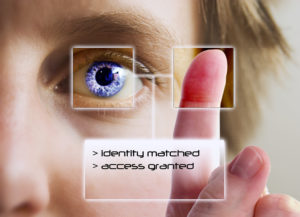
The system will know those 15 people’s names, their emergency numbers … Essentially, there would be different protocols of access based on more and more information pertinent to the individual, and the rights that those individuals have. Access to certain spaces is certainly going through a bit of a metamorphosis. Think of the movies in which someone can get hold of a guy’s eyeball, hold it up to a retina machine, and gain access to all the controls.
Or they could cut off a finger, and that’s not just in the movies.
Yes. Exactly. So what happens now is that it isn’t enough to get hold of that eyeball or finger. That biometric information, say, that particular person’s eyeball, had better be attached to that person’s body, and that person had better be alive. We’re gaining a granularity now, because of the access to greater and greater amounts of data, and big data. Our filtering mechanisms are becoming much more sophisticated through algorithms, and the emergence of what’s now called pattern recognition. As we start to move forward, the lockdown procedures, and the access controls to physical space, will become more and more refined for different types of systems within a building. Call the whole a “Building Siri.”
Artificial intelligence?
But very, very personalized. These Building Siris will become very commonplace, to where the building has a relationship with you. That building will know, because it has access to you — your emails, your text messages, your calendar, etcetera, that it’s you. It will also know what sort of mood you’re going to be in as you enter the lobby, there’s an empathy to it, to that Building Siri. That’s what we’ve learned with AI over time, people begin to trust it, trust a voice, because it’s at your place of work, your place of play, where you go to work out. Wherever you go, whatever your relationship is with the building, that building will begin to know you, just like your best friend.
That sounds, well, somewhat scary, perhaps and very intrusive …
It might be at first. But it’s a relationship of trust, a kind of trust relationship with a built environment that has never happened before. But because of how and where we’re going, in certain cases, we have to have that relationship of trust. For instance, we’re building this building in Jeddah right now [the Jeddah Tower, previously called the Kingdom Tower], which is the world’s tallest building. It’s going to be one kilometer tall. Now, lots of things can happen, as you might imagine, lots of catastrophic things. To start with, it’s also going to be the world’s largest terrorist target, just by default, because of where it is.
Security is obviously of prime concern.
We have to think of security first, but safety as well, and safety and security issues are going to need both macro and micro solutions. The micro solution is going to be that you have a trust relationship with that building over time. The building will let you know, for example, if you feel the building sway, that your anxiety over the building collapsing or something, is okay, but you really needn’t worry.
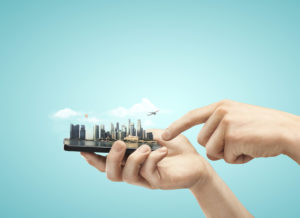
© Peshkova | Dreamstime.com
You’re saying it’s like having building therapy!
It will almost be like therapy in a sense, where it will listen to you and reassure you, and you’re okay with it doing that. That conversation, or reassurance, could be about anything: What if there’s a fire, and you need to get down, or there’s an explosion of some sort? It will tell you what to do.
Having that trust relationship is two-way, the building also knows that your safety is its primary objective and responsibility. So instead of following some instructions like a floor plan near an elevator that says, “In case of emergency, take this stair” or something, this is much more.
Well, it would need to be more, with the world’s tallest building, wouldn’t it?
Yes, at a kilometer tall, that floor plan pointing to the nearest exit to run out of is probably not the best solution you want! But a building that is programmed to understand that it needs to follow a certain protocol level depending on the situation, which understands that there are certain things that need to happen under certain conditions, which talks to you and reassures you, and is your constant companion, those are the kind of developments we’re now seeing being accelerated.
There’s a but in there somewhere?
The but is because this is all now happening at such speed, and in such a way, that at some not too distant point in the future, we’re also going to have to rein in the public blowout over something like this.
Because it would scare the hell out of people.
Yeah, because it would spook a lot of people. But all that technology exists right now. And the way we’re moving, it has to exist for people’s own safety and security, which is why building that trust with built spaces is so important.
Including at the macro level?
Including the macro solutions. So at the micro level, the solution would be a Building Siri having a relationship with you at any particular moment, at the macro level, it would be about the building protocols we’re be looking at.
Could you be more specific about those protocols?
Let’s take the center of the building as the center of the target. Move outward concentrically, one kilometer at a time, till you hit 100 km. A hundred kilometers out from the center of the building, that’s when the security protocols kick in. Certain things happen from that point, through tools like surveillance, through the use of tools like what Biometrica has.
You mean using security and surveillance technology to map and monitor the physical world?
Yes. You can map that area as the stage from where we start to pay attention to anything that happens, perceived threats, cyber and physical. One kilometer in, each time, as you go in concentrically 99 times, there are different escalations of cyber and physical protocols that have to be put in place. So if you’re tracking someone that’s on an Interpol list, and they enter that 100 km perimeter, now a certain sequence of events begins to happen, of tracking, of surveillance, of interception, potentially.
And the protocols depend on the kind of threat, of course.
If it’s physical, whether it’s a missile, a bomb, some sort of threat, yes, there are protocols that go into effect, concentrically out, to 100 km. We also do that underground, up to 5 km, and then 3 km aboveground. So it’s a three-dimensional matrix, almost like a Rubik’s Cube, that we’re tracking, cyber and physical threats, weaknesses, but also our strengths, and potential opportunities.
Like a SWOT analysis?
We do use a SWOT analysis through the entire process. It’s a fascinating exercise that we go through at the macro level, which will then affect how Building Siri talks to you, when she tells you what to do, potentially ahead of time, so you’re never in danger. That’s what we’re seeing as what the future of Smart Cities is really about. It’s really about safety and security, and the better use of experiences as an after-effect of that.
[Part II of this discussion with Paul Doherty, including a focus on securing a building as an organism, the importance of analytics, ops centers in Smart Cities, dealing with threats in urban environments, and transparency in times of terror, and how physical worlds need to be smarter, will appear in the Biometrica Blogs on Tuesday, Aug. 30, 2016.]